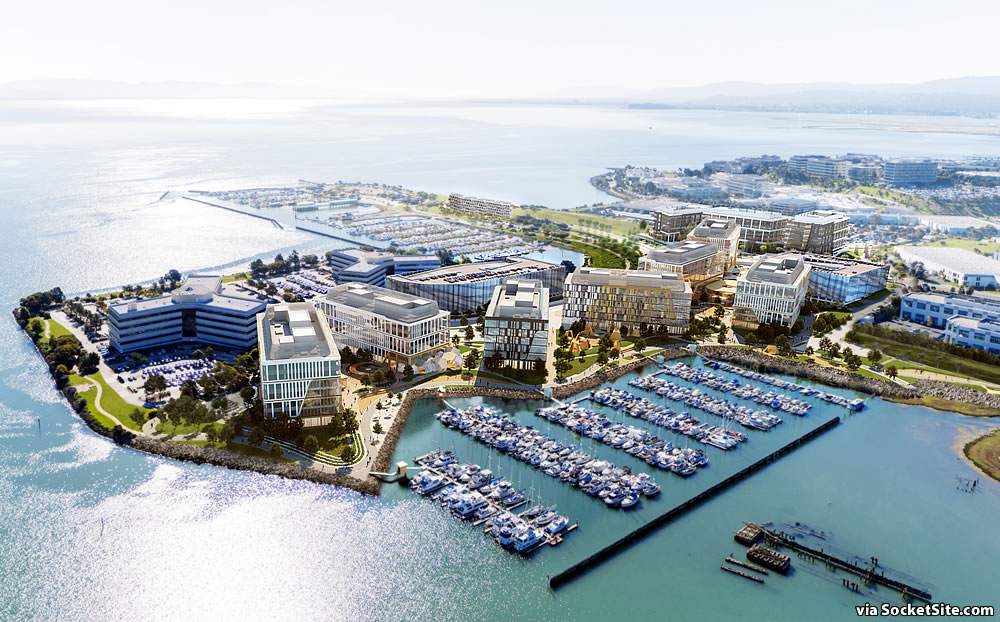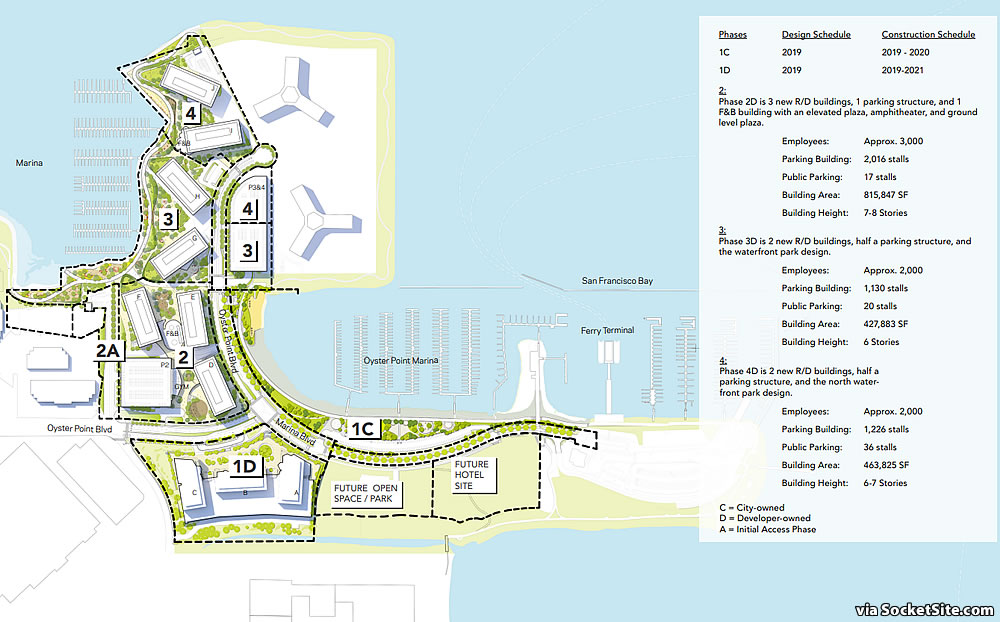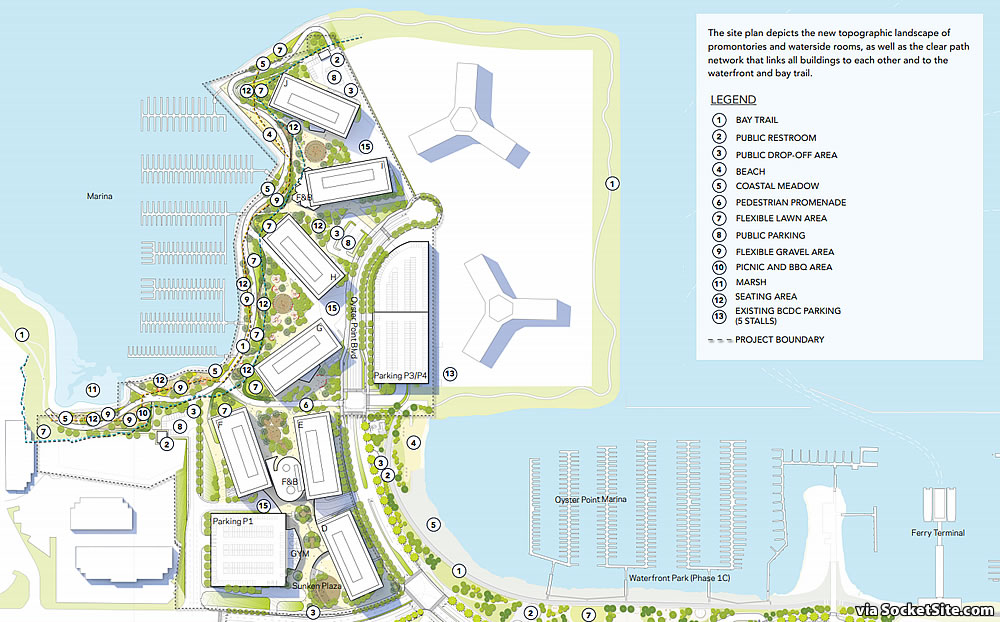With the first phase of Kilroy Reality’s massive Oyster Point development underway, Kilroy’s precise plan for the remaining four phases of the 31-acre project, which has been entitled but still needs to be approved, will be presented to the Design Review Board of the San Francisco Bay Conservation and Development Commission (BCDC) next week.
As envisioned by James Corner Field Operations with NBBJ, the redevelopment will yield 1.7 million square feet of office, research and development space, spread across eight buildings rising up to eight stories in height when completed, along with a central campus food and beverage building, an elevated plaza, an amphitheater, a ground-level plaza and two parking structures with a total of around 4,500 parking spaces (which would accommodate the projected needs of between 8,000 and 10,000 employees).
In addition to a network of new bike lanes, pathways and publicly accessible plazas, the master plan for the development includes a new beach, picnic and bbq areas, lawns and a widened and upgraded continuous Bay Trail.
And in terms of future proofing the project, the new buildings are being designed to be resilient to the maximum assumed sea level rise at the year 2100 (which is currently 66 inches).



Looks well-positioned for rising seas.
A proposal even worse than most SF office proposals as there is no housing. And public transportation is not good to this area. Add in Baylands (9 million feet of office space with a small housing component) and these two projects alone will overwhelm whatever housing ends up being built at Lennar’s HP/CP development This makes it important that Lennar’s project be re-evaluated and perhaps the office component dropped and reconfigured with housing. Ironically, these projects will draw tech companies out of SF (one major firm recently announced it is leaving the City for SSF) and reduce the demand for office space in SF. Better to reconfigure a good chunk of that to housing. If another BART tube is ever built it should run from the Oakland International airport area/Alameda and across the Bay to SSF. Especially as more mega office projects are in the works for SSF and the mid-Peninsula – with virtually no new housing in the works there. A good portion of the tens of thousands of new workers in the area will live in the East Bay.
Yes, build a BART tube as long as possible and make sure to finance it with bonds that does not have to repaid until it is completed around 95 years later. Great idea!
That’s the worst possible place to build another BART crossing.
A reminder that Peninsula housing NIMBY’s are even more strident that SF housing NIMBY’s.
Every Caltrain stop should be zoned much taller (but I know that’s never gonna happen).
If Proposition E passes on March 3, slashing the Prop M allocations in SF, lots of companies will expand in the burbs not in SF. Prop E of course will not generate a single housing unit, just drive jobs to transit inaccessible locations such as this.
There are also plenty of transit-ACCESSIBLE places in the burbs (Oakland – placed here for simplicity, not that I’m conceding it’s a “burb” – WC, Hayward, Fremont) where they can locate…if they wish to (indeed, even this is w/i shuttle ride from Bart and Caltrain lines). Locating in truly inaccessible places is a choice.
The proposed 4,500 parking spaces demonstrate what a folly is your shuttle ride “solution.”
And, the workers will still reside in SF, which means SF will get all the burden of the housing crunch, but none of the tax base. There are currently many people who work as far away as San Jose who live up here in the City—I am not sure how encouraging more of that helps the situation.
I work in biotech and in SSF. traffic there is already ridiculously bad. SSF is the center of biotech with over 200 biotech companies there, so this is why the massive development. the industry in growing and capital investment is very high right now. About 10 companies per year in Bay Area biotech go public, with about the same amount of Series As per year. A Series A for biotech averages now around $50M vs. $5-10M in tech.
There was a proposal for housing, which was heavily lobbied against by the industry there. Not sure if SS coverd back then, but was a story about a year ago. There is some new housing in SSF on other side of freeway but very little.
Regarding where people live who work here, I would say its good mix of San Mateo County, SF and East Bay, with some from Santa Clara. I doubt more than 20% of workforce lives in SF, but would guess less than 5% actually live in SSF. Biotech average employee age probably 10 yrs older than tech. There should be much more housing in and around this area. Brisbane housing would greatly help and the Baylands should seriously be 10K units instead of whats proposed. Candlestick/Bayview housing could also help as short commute.
In SSF, where the average RESIDENT has a substantially lower avg salary than most of Bay Area and is much less white, there is a strong push against new housing for fear of gentrification. I dont agree with this opinion, but sharing. Some people take Caltrain, but not many from my experience. With Stripe also moving down here, that tech migration might continue due to bad SF tax policies and the street misery. Biotech never really took off as planned in Mission bay because tech could afford much higher rents and ended up taking a lot of space. I think there may be 20 biotech companies in Mission Bay compared to >200 in SSF.
Why would the companies lobby against housing? Competition for land?
The reason biotech companies are against housing in Oyster Point is that they don’t want NIMBYs to move near their labs/offices and start to petition the restriction of future expansion of lab space, etc…
competition for land. many of the companies are expanding and new ones coming in.
It is true that E will not generate housing but E is a reaction to years and years of developers not producing housing. They go ahead and build office space and donate land for housing which sits vacant for years and years. City government allowed this and it has caught up with them. E will effectively end major office development in SF for a long time – and ironically slow housing development. The fact being that housing development is now problematic in SF. It does not pencil and especially “affordable” units. With other Bay Area locations like SSF wiling to approve office space with no significant housing to complement required, developers will walk away from SF. No more major office development but too, unfortunately, housing development will also collapse. The silver lining – SF is built out.
So, don’t build either housing or office space? Many wealthy workers continue to displace less affluent individuals for the ever more limited housing? And, then the office space goes to the suburbs where they are also not building housing, but they get to enjoy the tax base the commercial development while SF misses out. If that is your idea of a “silver lining,” I shudder to think what your worst case scenario would be.
prop E will slow housing as opposed to add
No. The first clause of your first sentence was a classic straw man because you don’t have a sensible response to what Dave wrote immediately above. There is nothing in Prop E to prevent developers from building housing, and in fact what is designed to do is direct the abundant capital flowing around The City away from office space and into what it’s residents and workers need: more housing.
Capital is not finite, and if the city was interested in attracting more of it to building housing, there are many levers it can use to that end. All Prop E will do is have white collar employees drive to their jobs in SSF from their TIC in the Mission, instead of maybe taking BART to downtown today.
Don’t you guys read this site? Rents are soft and house prices are going down. There’s plenty of room at the inn. /s/
You take a bus to your boat?? Sea rise clown show waiting to happen.
Is relatively well serviced by transit. There’s a ferry terminal from East Bay <10 mins away. WETA keeps buying more boats, so the 4 morning boats will probably be expanded.
Caltrain is 1.3 miles away, so easy bike/scooter ride, but there'll likely be enough demand for a shuttle to take employees to the station which will likely see service every 30 mins in a few years once Caltrain is electrified.
I think if they threw some incentives where parking costs are withheld from paychecks, the usage numbers will go up.
agreed!
many of the companies there already provide transportation incentives, but oyster point blvd is still pretty gridlocked already and this will exacerbate the issue. there are already a lot of shuttles from SF, as well as from South City BART station. there needs to be more housing around the south city BART station and the south city caltrain, and potentially some housing on the east side of 101. Brisbane really needs to step up as well
i wonder if it was easier to build a spec biotech HQ and rent it out -or- for the BioTech Cos to buy the land then build a HQ to suit them.
Ideally multiple 40+ floor buildings and multiple equivalent hi-rise condos with a ton of their own parking.
HQ + residences + waterfront everything + no commute, just walk to work. streets lined with gourmet food trucks.
Knuckleheads.
The latter option is what I would do if I were the CEO of a large company, BioTech or not, but Wall Street analysts tend to ding companies that attempt it and many shareholders that worship at the altar of shareholder value punish the stocks of companies that attempt it. The idea being that a company that should be focused on their products/services is veering away from their core competency by trying to plan and construct a building or a campus or housing for their employees.
Really big tech companies such as Facebook, Google and Apple can plan, build and own their own buildings, but for some reason Wall St. really likes it when most companies pay out potential earnings to commercial landlords. See the Salesforce debacle.
I would think if the muncipality could choose they would want a commercial landlord bc that property could be sold many times and the gov could get an updated property tax figure out of them. But a Corporate HQ may not turn over for 50+ years.
Plus I imagine the gov would work with a developer knowing there are more deals in the future but an HQ is a one-off deal and the gov would squeeze them as hard as possible.
Maybe the math of the Salesforce tower buying a spec-built tower saved them the BS of dealing with SF zoning and planning. Just reduce it to signing the check.
1) lacking transit solutions (MASS TRANSIT) LRV / trackless trains, e-shuttles, and any semblance or lessening traffic on I-101
2) Housing without addressing how lacking rental housing would be built or provided within this complex of buildings and at what levels of rents, or affordability.
3) rising sea water, seems a lot of money is being placed along the shoreline from SF southbound, but little coordination on the issue of climate change at this locale….
I agree with Dave above ….
Worked at a firm that did the same exact plan back in 2010ish or so. Corner Field Operations is just the catchy name firm now. Sea level rise, park at marina edge, same concept